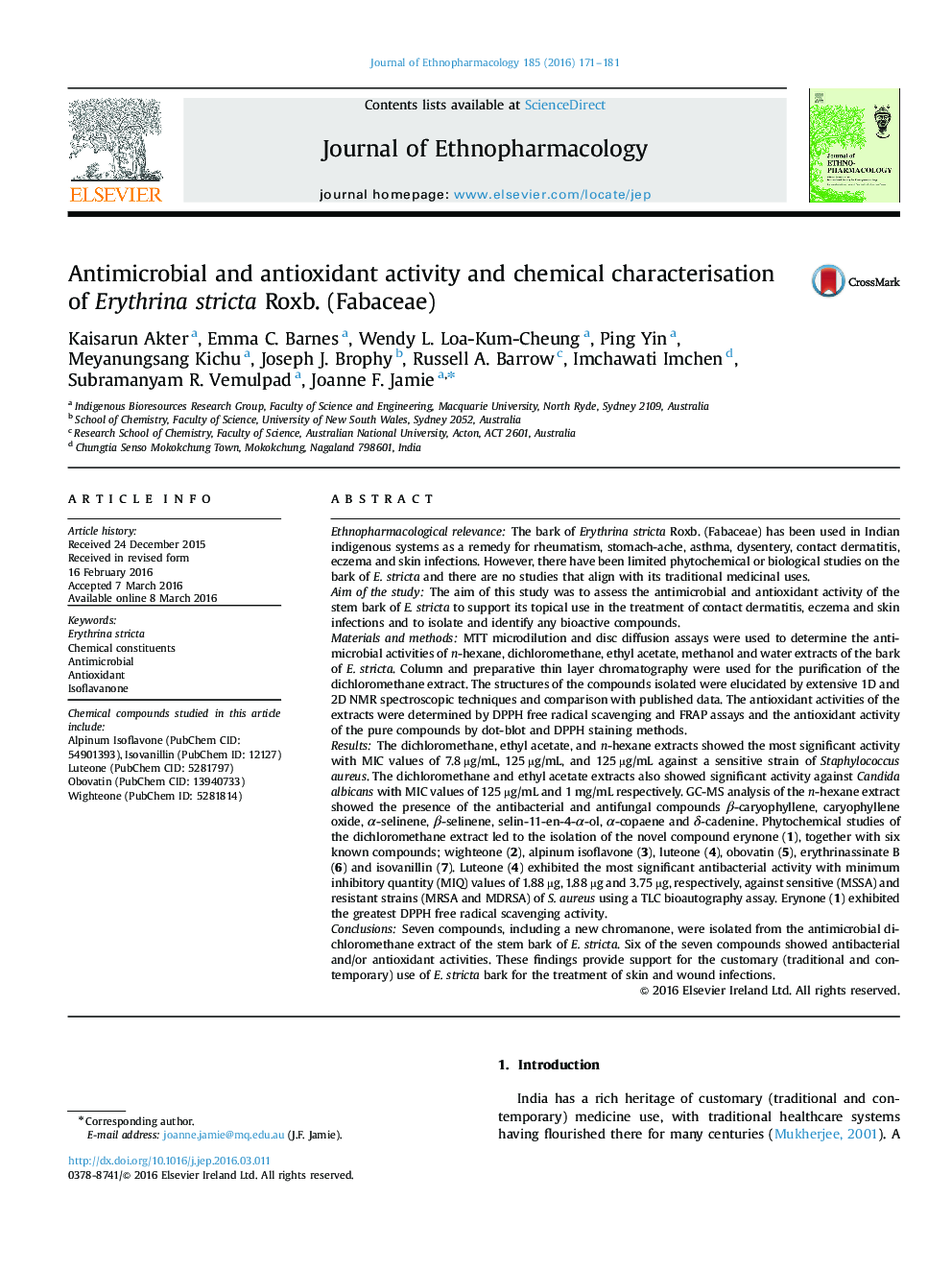| کد مقاله | کد نشریه | سال انتشار | مقاله انگلیسی | نسخه تمام متن |
|---|---|---|---|---|
| 2544839 | 1560377 | 2016 | 11 صفحه PDF | دانلود رایگان |

Ethnopharmacological relevanceThe bark of Erythrina stricta Roxb. (Fabaceae) has been used in Indian indigenous systems as a remedy for rheumatism, stomach-ache, asthma, dysentery, contact dermatitis, eczema and skin infections. However, there have been limited phytochemical or biological studies on the bark of E. stricta and there are no studies that align with its traditional medicinal uses.Aim of the studyThe aim of this study was to assess the antimicrobial and antioxidant activity of the stem bark of E. stricta to support its topical use in the treatment of contact dermatitis, eczema and skin infections and to isolate and identify any bioactive compounds.Materials and methodsMTT microdilution and disc diffusion assays were used to determine the antimicrobial activities of n-hexane, dichloromethane, ethyl acetate, methanol and water extracts of the bark of E. stricta. Column and preparative thin layer chromatography were used for the purification of the dichloromethane extract. The structures of the compounds isolated were elucidated by extensive 1D and 2D NMR spectroscopic techniques and comparison with published data. The antioxidant activities of the extracts were determined by DPPH free radical scavenging and FRAP assays and the antioxidant activity of the pure compounds by dot-blot and DPPH staining methods.ResultsThe dichloromethane, ethyl acetate, and n-hexane extracts showed the most significant activity with MIC values of 7.8 µg/mL, 125 µg/mL, and 125 µg/mL against a sensitive strain of Staphylococcus aureus. The dichloromethane and ethyl acetate extracts also showed significant activity against Candida albicans with MIC values of 125 µg/mL and 1 mg/mL respectively. GC-MS analysis of the n-hexane extract showed the presence of the antibacterial and antifungal compounds β-caryophyllene, caryophyllene oxide, α-selinene, β-selinene, selin-11-en-4-α-ol, α-copaene and δ-cadenine. Phytochemical studies of the dichloromethane extract led to the isolation of the novel compound erynone (1), together with six known compounds; wighteone (2), alpinum isoflavone (3), luteone (4), obovatin (5), erythrinassinate B (6) and isovanillin (7). Luteone (4) exhibited the most significant antibacterial activity with minimum inhibitory quantity (MIQ) values of 1.88 µg, 1.88 µg and 3.75 µg, respectively, against sensitive (MSSA) and resistant strains (MRSA and MDRSA) of S. aureus using a TLC bioautography assay. Erynone (1) exhibited the greatest DPPH free radical scavenging activity.ConclusionsSeven compounds, including a new chromanone, were isolated from the antimicrobial dichloromethane extract of the stem bark of E. stricta. Six of the seven compounds showed antibacterial and/or antioxidant activities. These findings provide support for the customary (traditional and contemporary) use of E. stricta bark for the treatment of skin and wound infections.
Figure optionsDownload high-quality image (201 K)Download as PowerPoint slide
Journal: Journal of Ethnopharmacology - Volume 185, 5 June 2016, Pages 171–181